transmission TOYOTA AURIS HYBRID 2011 Owners Manual
[x] Cancel search | Manufacturer: TOYOTA, Model Year: 2011, Model line: AURIS HYBRID, Model: TOYOTA AURIS HYBRID 2011Pages: 524, PDF Size: 26.34 MB
Page 2 of 524
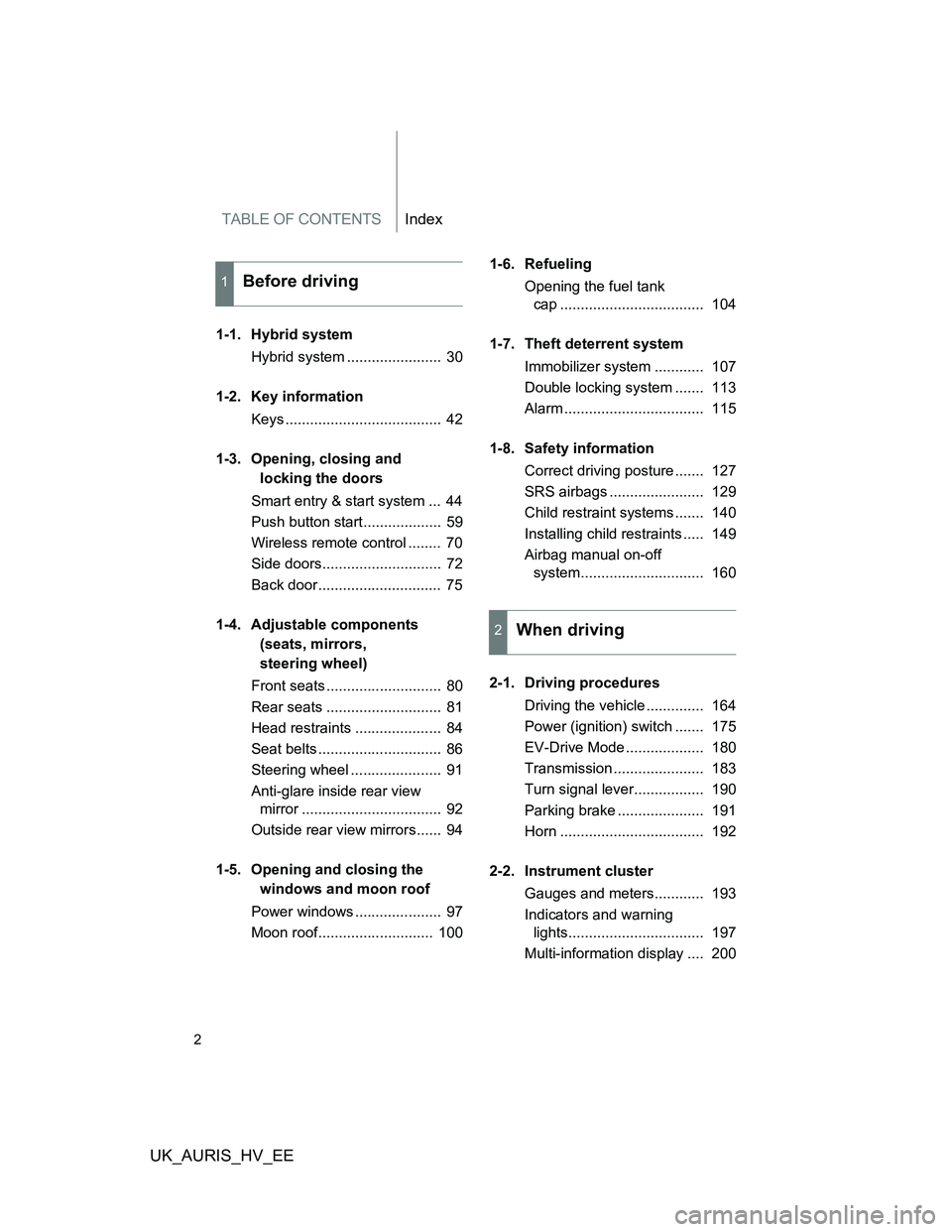
TABLE OF CONTENTSIndex
UK_AURIS_HV_EE
2
1-1. Hybrid system
Hybrid system ....................... 30
1-2. Key information
Keys ...................................... 42
1-3. Opening, closing and
locking the doors
Smart entry & start system ... 44
Push button start................... 59
Wireless remote control ........ 70
Side doors............................. 72
Back door.............................. 75
1-4. Adjustable components
(seats, mirrors,
steering wheel)
Front seats ............................ 80
Rear seats ............................ 81
Head restraints ..................... 84
Seat belts .............................. 86
Steering wheel ...................... 91
Anti-glare inside rear view
mirror .................................. 92
Outside rear view mirrors...... 94
1-5. Opening and closing the
windows and moon roof
Power windows ..................... 97
Moon roof............................ 1001-6. Refueling
Opening the fuel tank
cap ................................... 104
1-7. Theft deterrent system
Immobilizer system ............ 107
Double locking system ....... 113
Alarm .................................. 115
1-8. Safety information
Correct driving posture ....... 127
SRS airbags ....................... 129
Child restraint systems ....... 140
Installing child restraints ..... 149
Airbag manual on-off
system.............................. 160
2-1. Driving procedures
Driving the vehicle .............. 164
Power (ignition) switch ....... 175
EV-Drive Mode ................... 180
Transmission ...................... 183
Turn signal lever................. 190
Parking brake ..................... 191
Horn ................................... 192
2-2. Instrument cluster
Gauges and meters............ 193
Indicators and warning
lights................................. 197
Multi-information display .... 200
1Before driving
2When driving
Page 33 of 524
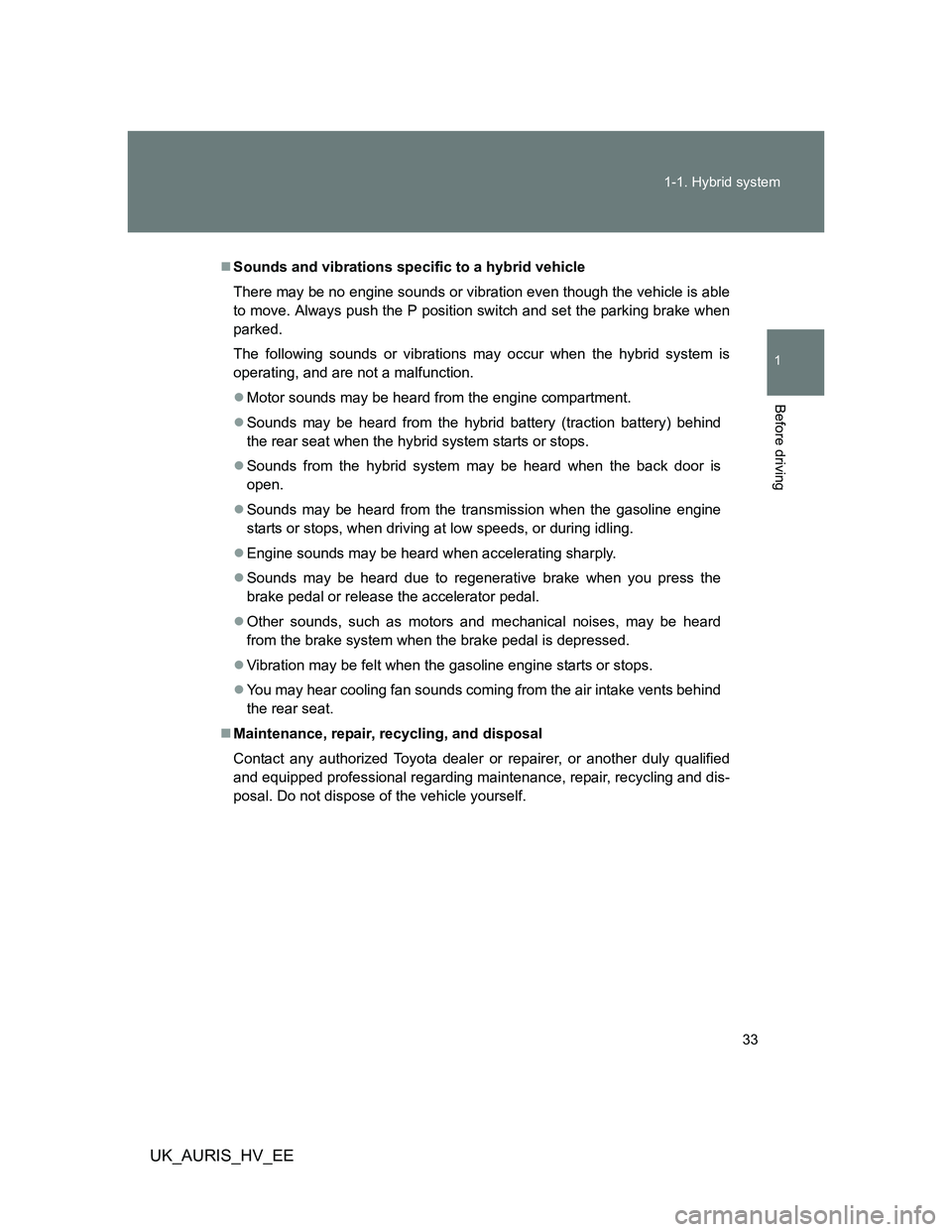
33 1-1. Hybrid system
1
Before driving
UK_AURIS_HV_EE
Sounds and vibrations specific to a hybrid vehicle
There may be no engine sounds or vibration even though the vehicle is able
to move. Always push the P position switch and set the parking brake when
parked.
The following sounds or vibrations may occur when the hybrid system is
operating, and are not a malfunction.
Motor sounds may be heard from the engine compartment.
Sounds may be heard from the hybrid battery (traction battery) behind
the rear seat when the hybrid system starts or stops.
Sounds from the hybrid system may be heard when the back door is
open.
Sounds may be heard from the transmission when the gasoline engine
starts or stops, when driving at low speeds, or during idling.
Engine sounds may be heard when accelerating sharply.
Sounds may be heard due to regenerative brake when you press the
brake pedal or release the accelerator pedal.
Other sounds, such as motors and mechanical noises, may be heard
from the brake system when the brake pedal is depressed.
Vibration may be felt when the gasoline engine starts or stops.
You may hear cooling fan sounds coming from the air intake vents behind
the rear seat.
Maintenance, repair, recycling, and disposal
Contact any authorized Toyota dealer or repairer, or another duly qualified
and equipped professional regarding maintenance, repair, recycling and dis-
posal. Do not dispose of the vehicle yourself.
Page 163 of 524
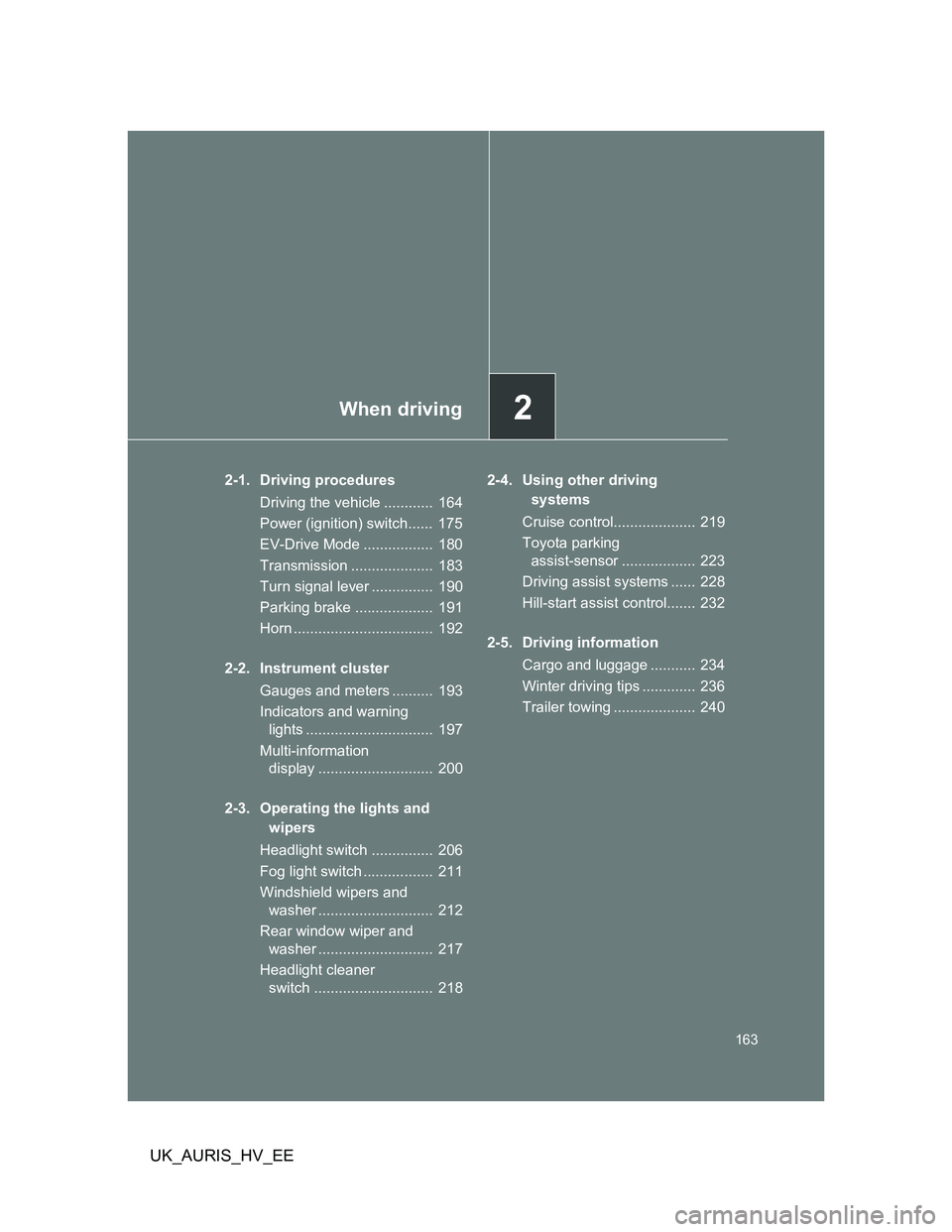
2When driving
163
UK_AURIS_HV_EE
2-1. Driving procedures
Driving the vehicle ............ 164
Power (ignition) switch...... 175
EV-Drive Mode ................. 180
Transmission .................... 183
Turn signal lever ............... 190
Parking brake ................... 191
Horn .................................. 192
2-2. Instrument cluster
Gauges and meters .......... 193
Indicators and warning
lights ............................... 197
Multi-information
display ............................ 200
2-3. Operating the lights and
wipers
Headlight switch ............... 206
Fog light switch ................. 211
Windshield wipers and
washer ............................ 212
Rear window wiper and
washer ............................ 217
Headlight cleaner
switch ............................. 2182-4. Using other driving
systems
Cruise control.................... 219
Toyota parking
assist-sensor .................. 223
Driving assist systems ...... 228
Hill-start assist control....... 232
2-5. Driving information
Cargo and luggage ........... 234
Winter driving tips ............. 236
Trailer towing .................... 240
Page 169 of 524
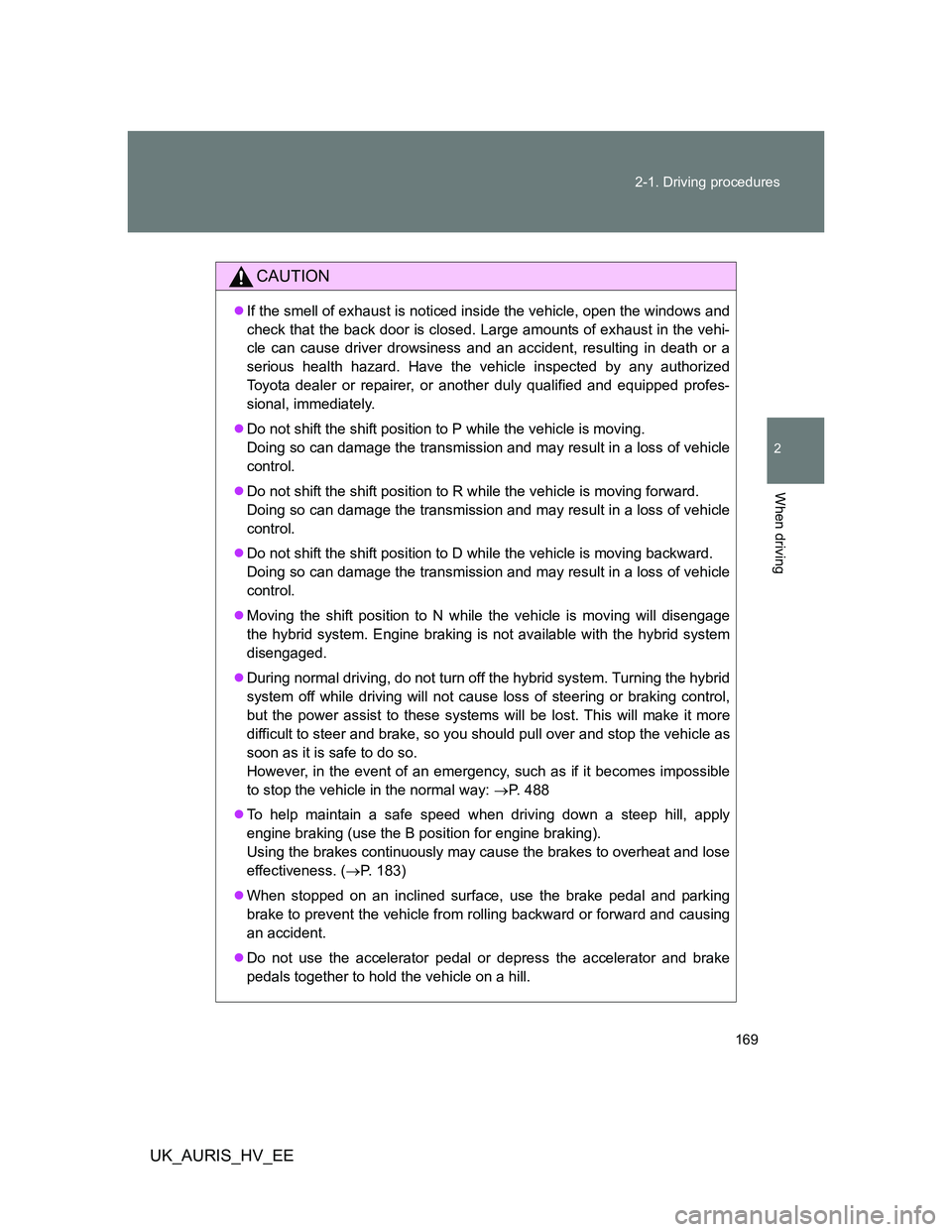
169 2-1. Driving procedures
2
When driving
UK_AURIS_HV_EE
CAUTION
If the smell of exhaust is noticed inside the vehicle, open the windows and
check that the back door is closed. Large amounts of exhaust in the vehi-
cle can cause driver drowsiness and an accident, resulting in death or a
serious health hazard. Have the vehicle inspected by any authorized
Toyota dealer or repairer, or another duly qualified and equipped profes-
sional, immediately.
Do not shift the shift position to P while the vehicle is moving.
Doing so can damage the transmission and may result in a loss of vehicle
control.
Do not shift the shift position to R while the vehicle is moving forward.
Doing so can damage the transmission and may result in a loss of vehicle
control.
Do not shift the shift position to D while the vehicle is moving backward.
Doing so can damage the transmission and may result in a loss of vehicle
control.
Moving the shift position to N while the vehicle is moving will disengage
the hybrid system. Engine braking is not available with the hybrid system
disengaged.
During normal driving, do not turn off the hybrid system. Turning the hybrid
system off while driving will not cause loss of steering or braking control,
but the power assist to these systems will be lost. This will make it more
difficult to steer and brake, so you should pull over and stop the vehicle as
soon as it is safe to do so.
However, in the event of an emergency, such as if it becomes impossible
to stop the vehicle in the normal way: P. 488
To help maintain a safe speed when driving down a steep hill, apply
engine braking (use the B position for engine braking).
Using the brakes continuously may cause the brakes to overheat and lose
effectiveness. (P. 183)
When stopped on an inclined surface, use the brake pedal and parking
brake to prevent the vehicle from rolling backward or forward and causing
an accident.
Do not use the accelerator pedal or depress the accelerator and brake
pedals together to hold the vehicle on a hill.
Page 174 of 524
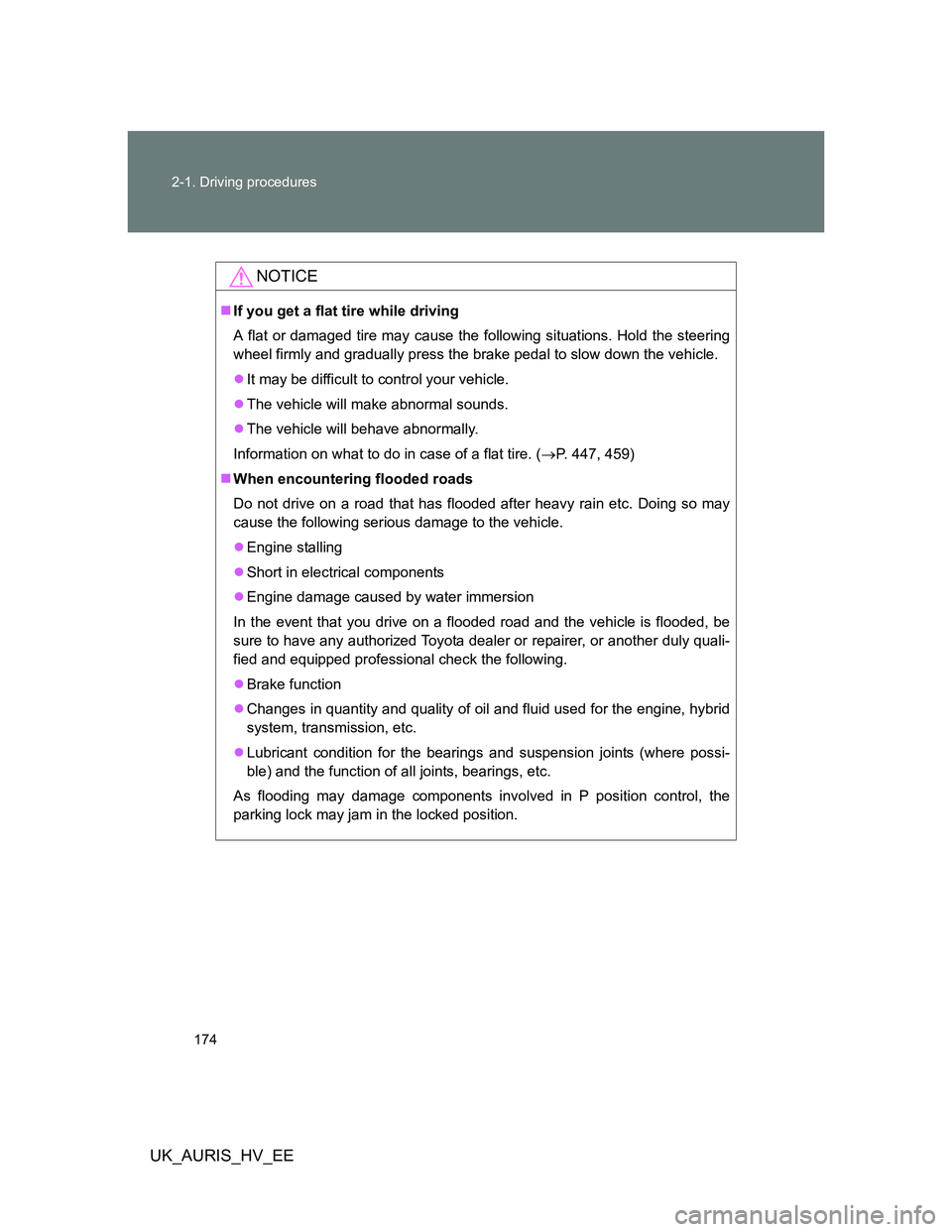
174 2-1. Driving procedures
UK_AURIS_HV_EE
NOTICE
If you get a flat tire while driving
A flat or damaged tire may cause the following situations. Hold the steering
wheel firmly and gradually press the brake pedal to slow down the vehicle.
It may be difficult to control your vehicle.
The vehicle will make abnormal sounds.
The vehicle will behave abnormally.
Information on what to do in case of a flat tire. (P. 447, 459)
When encountering flooded roads
Do not drive on a road that has flooded after heavy rain etc. Doing so may
cause the following serious damage to the vehicle.
Engine stalling
Short in electrical components
Engine damage caused by water immersion
In the event that you drive on a flooded road and the vehicle is flooded, be
sure to have any authorized Toyota dealer or repairer, or another duly quali-
fied and equipped professional check the following.
Brake function
Changes in quantity and quality of oil and fluid used for the engine, hybrid
system, transmission, etc.
Lubricant condition for the bearings and suspension joints (where possi-
ble) and the function of all joints, bearings, etc.
As flooding may damage components involved in P position control, the
parking lock may jam in the locked position.
Page 183 of 524
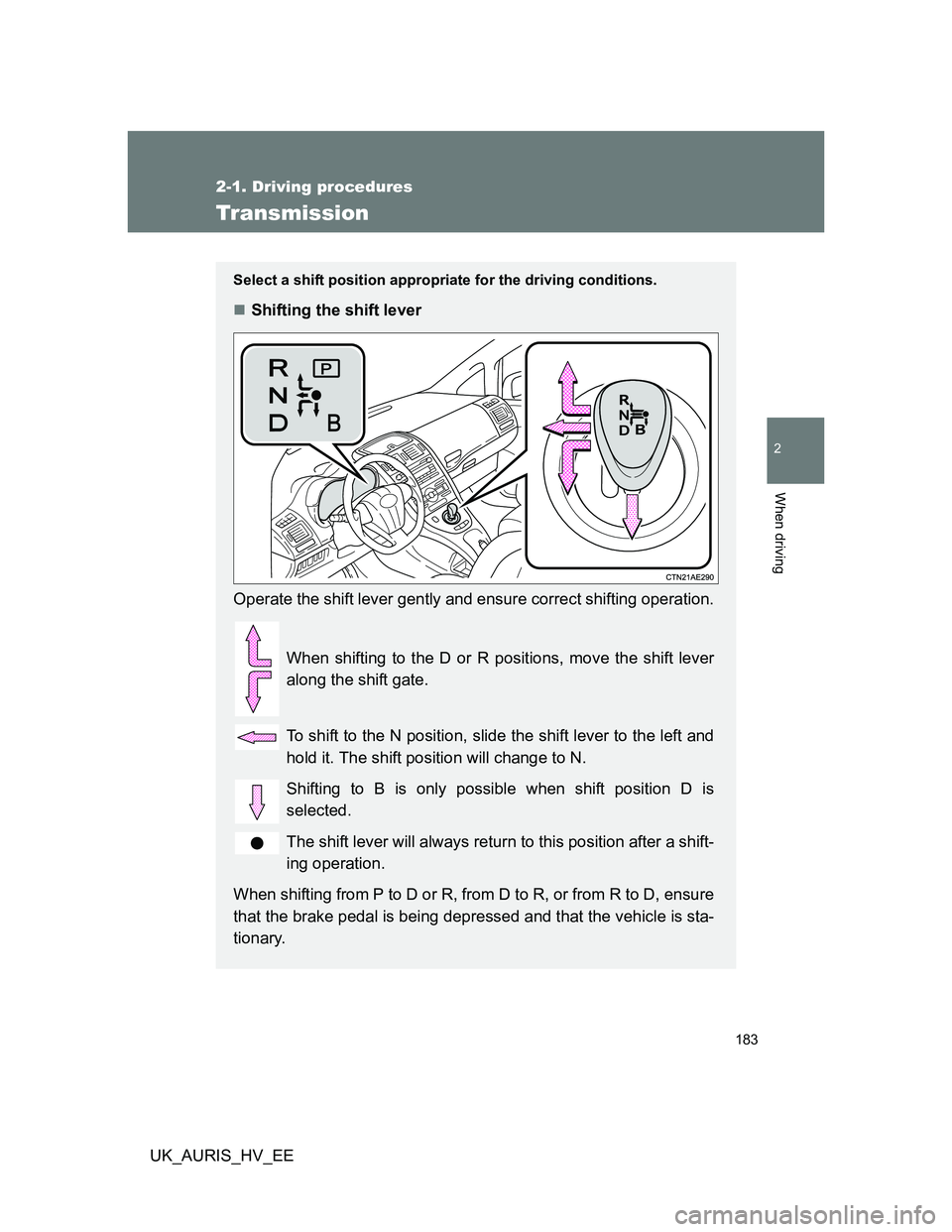
183
2-1. Driving procedures
2
When driving
UK_AURIS_HV_EE
Transmission
Select a shift position appropriate for the driving conditions.
Shifting the shift lever
Operate the shift lever gently and ensure correct shifting operation.
When shifting to the D or R positions, move the shift lever
along the shift gate.
To shift to the N position, slide the shift lever to the left and
hold it. The shift position will change to N.
Shifting to B is only possible when shift position D is
selected.
The shift lever will always return to this position after a shift-
ing operation.
When shifting from P to D or R, from D to R, or from R to D, ensure
that the brake pedal is being depressed and that the vehicle is sta-
tionary.
Page 187 of 524
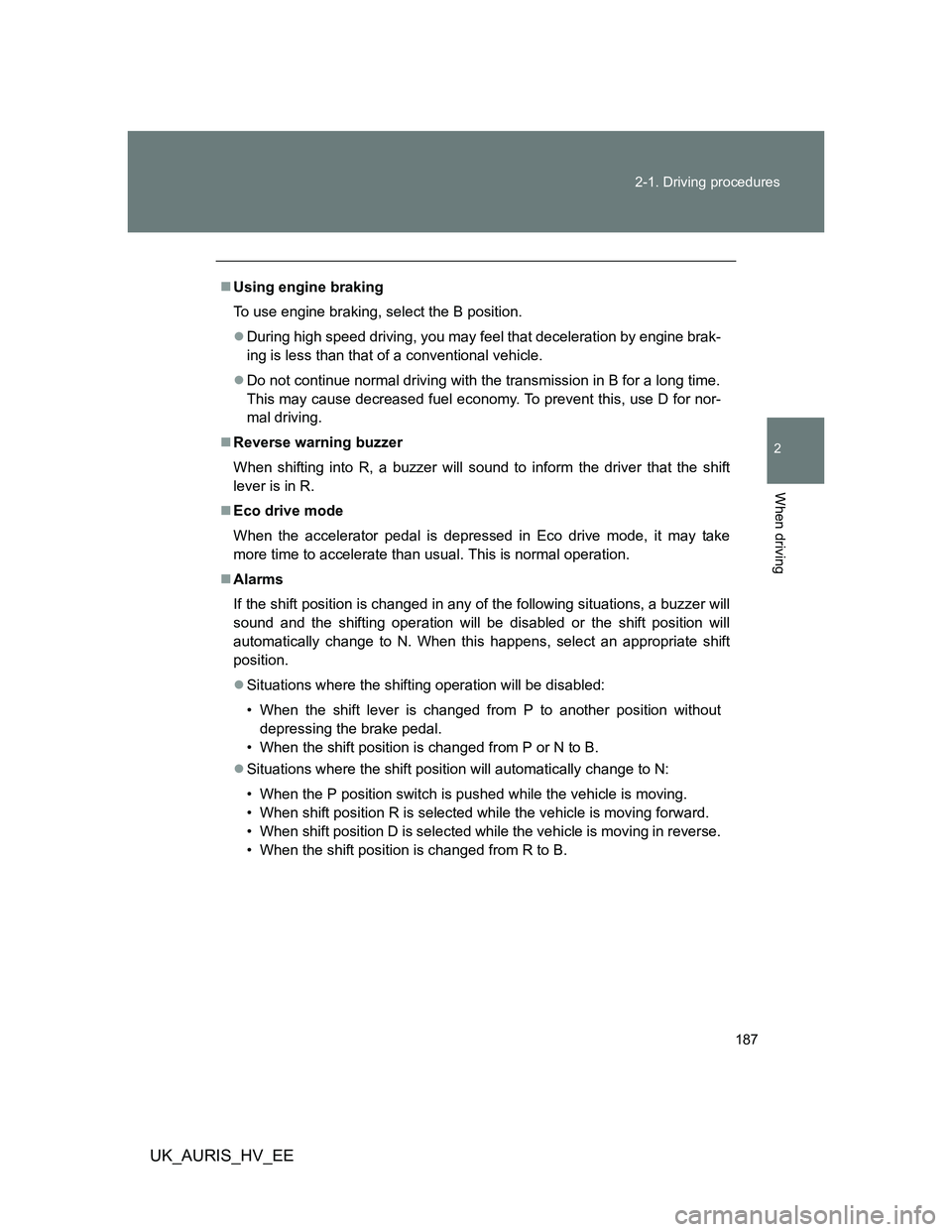
187 2-1. Driving procedures
2
When driving
UK_AURIS_HV_EE
Using engine braking
To use engine braking, select the B position.
During high speed driving, you may feel that deceleration by engine brak-
ing is less than that of a conventional vehicle.
Do not continue normal driving with the transmission in B for a long time.
This may cause decreased fuel economy. To prevent this, use D for nor-
mal driving.
Reverse warning buzzer
When shifting into R, a buzzer will sound to inform the driver that the shift
lever is in R.
Eco drive mode
When the accelerator pedal is depressed in Eco drive mode, it may take
more time to accelerate than usual. This is normal operation.
Alarms
If the shift position is changed in any of the following situations, a buzzer will
sound and the shifting operation will be disabled or the shift position will
automatically change to N. When this happens, select an appropriate shift
position.
Situations where the shifting operation will be disabled:
• When the shift lever is changed from P to another position without
depressing the brake pedal.
• When the shift position is changed from P or N to B.
Situations where the shift position will automatically change to N:
• When the P position switch is pushed while the vehicle is moving.
• When shift position R is selected while the vehicle is moving forward.
• When shift position D is selected while the vehicle is moving in reverse.
• When the shift position is changed from R to B.
Page 423 of 524
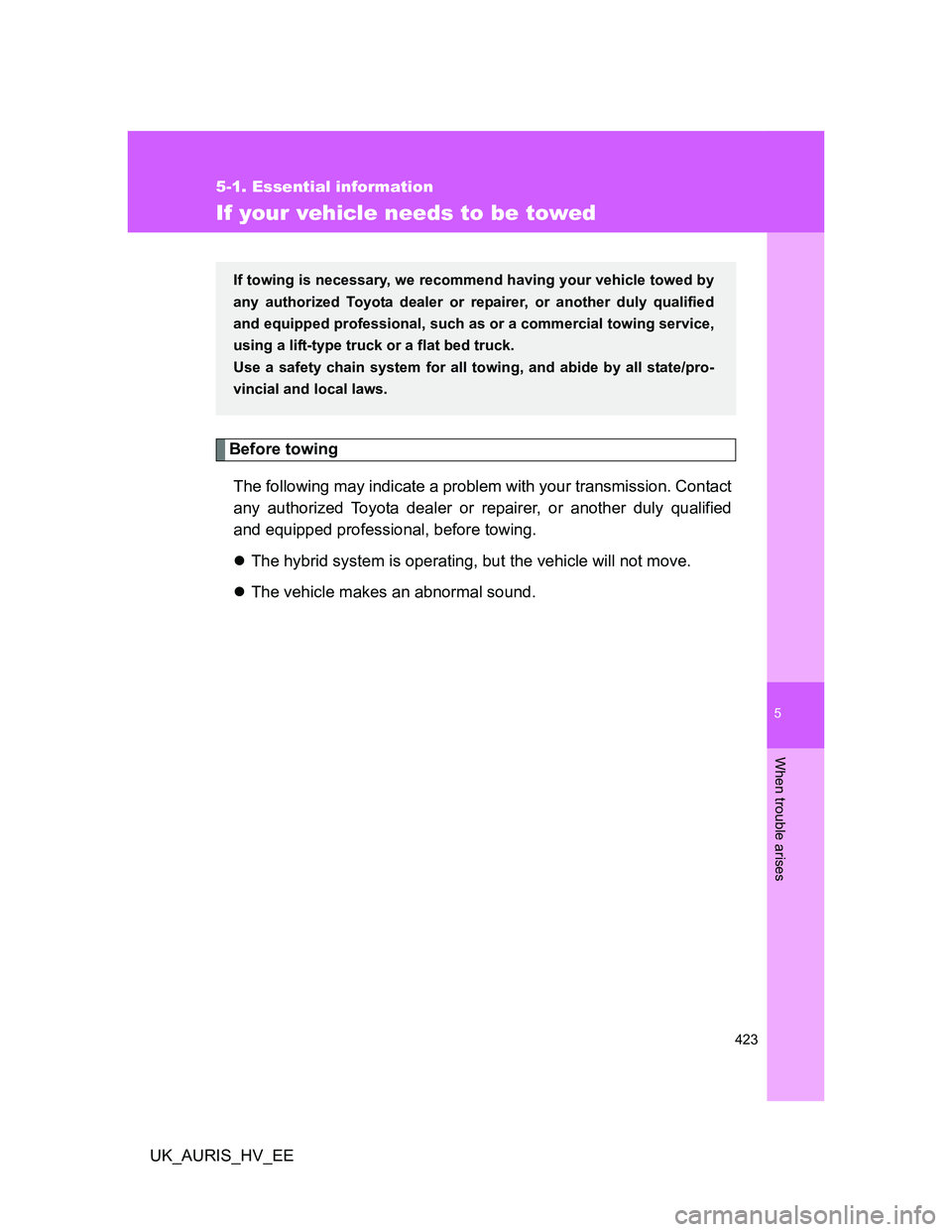
5
423
5-1. Essential information
When trouble arises
UK_AURIS_HV_EE
If your vehicle needs to be towed
Before towing
The following may indicate a problem with your transmission. Contact
any authorized Toyota dealer or repairer, or another duly qualified
and equipped professional, before towing.
The hybrid system is operating, but the vehicle will not move.
The vehicle makes an abnormal sound.
If towing is necessary, we recommend having your vehicle towed by
any authorized Toyota dealer or repairer, or another duly qualified
and equipped professional, such as or a commercial towing service,
using a lift-type truck or a flat bed truck.
Use a safety chain system for all towing, and abide by all state/pro-
vincial and local laws.
Page 428 of 524
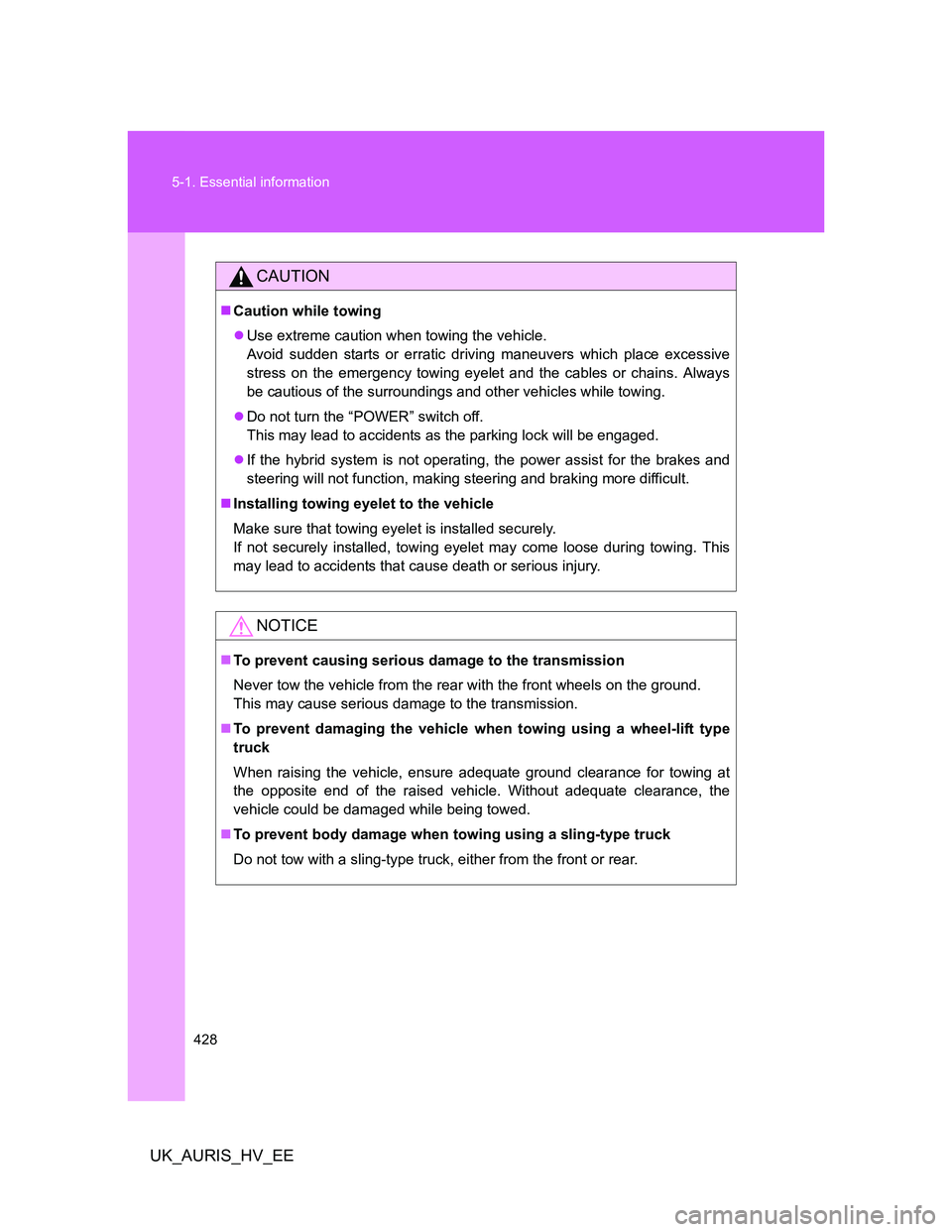
428 5-1. Essential information
UK_AURIS_HV_EE
CAUTION
Caution while towing
Use extreme caution when towing the vehicle.
Avoid sudden starts or erratic driving maneuvers which place excessive
stress on the emergency towing eyelet and the cables or chains. Always
be cautious of the surroundings and other vehicles while towing.
Do not turn the “POWER” switch off.
This may lead to accidents as the parking lock will be engaged.
If the hybrid system is not operating, the power assist for the brakes and
steering will not function, making steering and braking more difficult.
Installing towing eyelet to the vehicle
Make sure that towing eyelet is installed securely.
If not securely installed, towing eyelet may come loose during towing. This
may lead to accidents that cause death or serious injury.
NOTICE
To prevent causing serious damage to the transmission
Never tow the vehicle from the rear with the front wheels on the ground.
This may cause serious damage to the transmission.
To prevent damaging the vehicle when towing using a wheel-lift type
truck
When raising the vehicle, ensure adequate ground clearance for towing at
the opposite end of the raised vehicle. Without adequate clearance, the
vehicle could be damaged while being towed.
To prevent body damage when towing using a sling-type truck
Do not tow with a sling-type truck, either from the front or rear.
Page 432 of 524
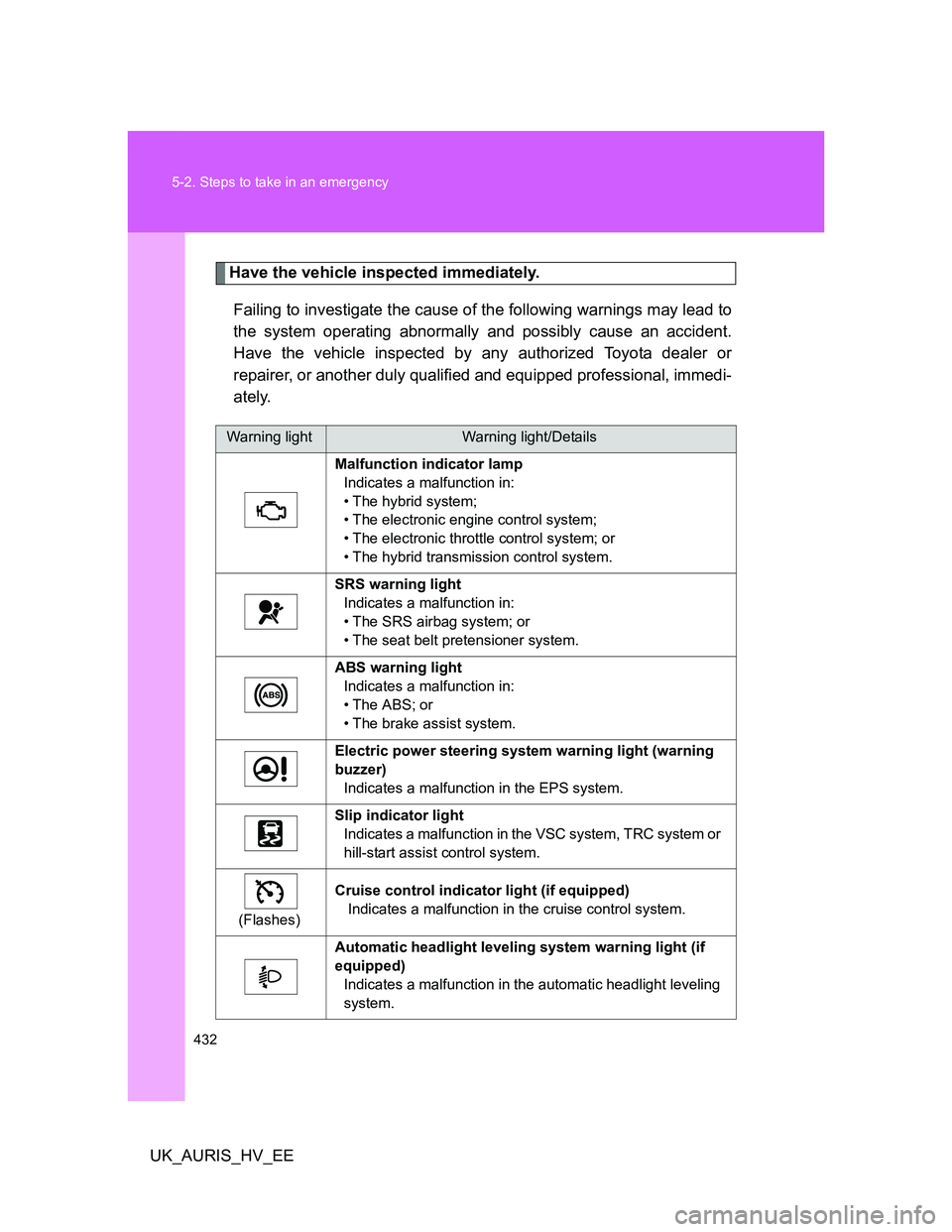
432 5-2. Steps to take in an emergency
UK_AURIS_HV_EE
Have the vehicle inspected immediately.
Failing to investigate the cause of the following warnings may lead to
the system operating abnormally and possibly cause an accident.
Have the vehicle inspected by any authorized Toyota dealer or
repairer, or another duly qualified and equipped professional, immedi-
ately.
Warning lightWarning light/Details
Malfunction indicator lamp
Indicates a malfunction in:
• The hybrid system;
• The electronic engine control system;
• The electronic throttle control system; or
• The hybrid transmission control system.
SRS warning light
Indicates a malfunction in:
• The SRS airbag system; or
• The seat belt pretensioner system.
ABS warning light
Indicates a malfunction in:
• The ABS; or
• The brake assist system.
Electric power steering system warning light (warning
buzzer)
Indicates a malfunction in the EPS system.
Slip indicator light
Indicates a malfunction in the VSC system, TRC system or
hill-start assist control system.
(Flashes)Cruise control indicator light (if equipped)
Indicates a malfunction in the cruise control system.
Automatic headlight leveling system warning light (if
equipped)
Indicates a malfunction in the automatic headlight leveling
system.